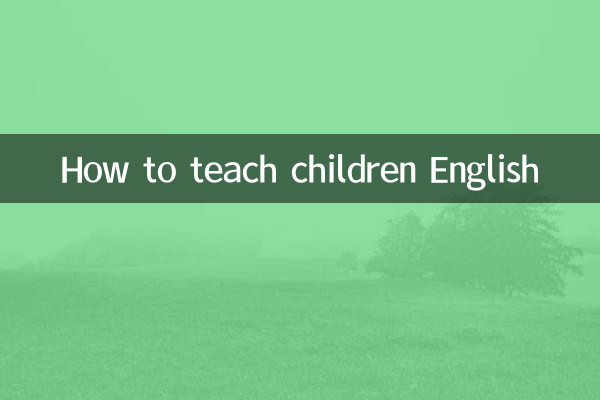How to teach children English: Popular methods and structured data analysis on the entire network
In today's era of globalization, the importance of English as an international language is self-evident. Many parents hope to cultivate their children's English skills from an early age, but how to teach efficiently is a common problem. This article combines popular topics and hot contents on the Internet for the past 10 days to provide you with a systematic guide to help you teach your children English scientifically.
1. A list of popular English teaching methods

According to the recent discussions on education platforms and social media, the following are the five most popular English teaching methods for children:
| Method name | Core features | Suitable for age | Popularity index |
|---|---|---|---|
| Immersive teaching method | Create an all-English environment | 3-12 years old | ★★★★★ |
| TPR (Solid-body Response) Teaching Method | Learn language through action | 2-8 years old | ★★★★☆ |
| Natural spelling | Emphasize pronunciation rules | 4-10 years old | ★★★★☆ |
| Gamified learning | Master language through games | 3-12 years old | ★★★☆☆ |
| Bilingual picture book reading | Combining story and language learning | 2-10 years old | ★★★☆☆ |
2. Five major issues that parents care about most
Through data analysis of parenting forums and question-and-answer platforms, parents most often encounter the following problems when teaching their children English:
| Question Category | Frequency of occurrence | Solution keywords |
|---|---|---|
| The child is not interested in English | 35.7% | Gamified teaching and reward mechanism |
| Not standard pronunciation | 28.2% | Original sound input and pronunciation training |
| Can't remember words | 19.5% | Repeated memory, scene application |
| Syntax obfuscation | 12.3% | Simplified rules, example sentence demonstration |
| Lack of locale | 4.3% | Home English corner, online resources |
3. Suggestions for scientific teaching schedule
According to the research on children's psychology and language learning rules, the English learning time of children of different ages should be different:
| Age group | Daily recommended duration | Best time to study | Study format suggestions |
|---|---|---|---|
| 2-3 years old | 15-20 minutes | 10-11 am | Children's songs, simple words |
| 4-6 years old | 25-30 minutes | 3-5 pm | Games, picture books |
| 7-9 years old | 30-45 minutes | 7-8 pm | Conversation, reading |
| 10-12 years old | 45-60 minutes | 4-6 pm | Systematic learning and writing |
4. Recommended popular English learning resources
Combined with recent downloads and user reviews, the following resources have been widely praised by parents:
| Resource Type | Recommended name | Applicable age | feature |
|---|---|---|---|
| APP | Lingokids | 2-8 years old | Interactive game learning |
| Animation | Peppa Pig | 3-10 years old | Life-oriented dialogue |
| Picture Book | Brown Bear Series | 2-6 years old | Repeat sentence pattern |
| Children's songs | Super Simple Songs | 2-8 years old | Combination of action |
5. Key points for teaching
1.Stay positive:Parents' emotions directly affect their children's interest in learning and avoid forced learning.
2.Pay attention to daily input:Getting in English at a fixed time every day is more effective than sudden learning.
3.Multi-sensory stimulation:Combining listening, speaking, watching, and moving methods to improve learning results.
4.Set reasonable goals:Set small goals that can be achieved based on the child's age and ability.
5.Create real scenes:Apply English through practical scenarios such as role-playing and shopping.
English teaching is a gradual process, and parents need to be patient and constantly adjust their methods based on their children's feedback. Combining scientific teaching methods and high-quality learning resources, I believe that every child can master the important language of English in a relaxed and pleasant atmosphere.

check the details